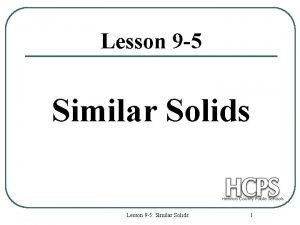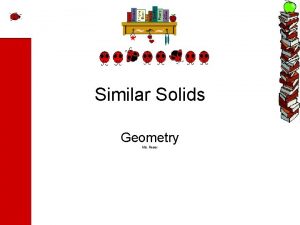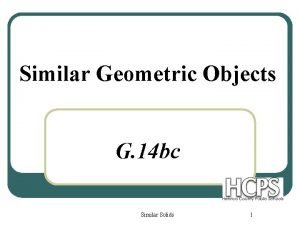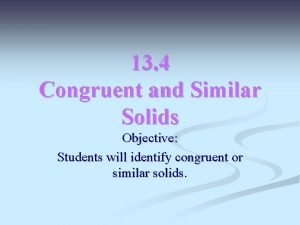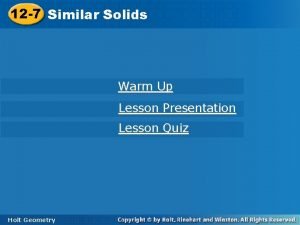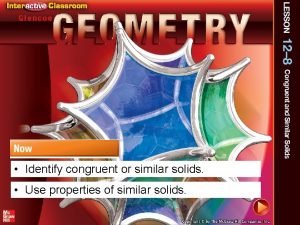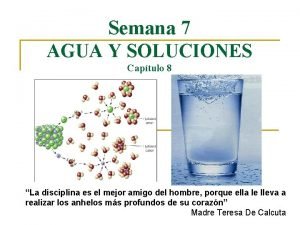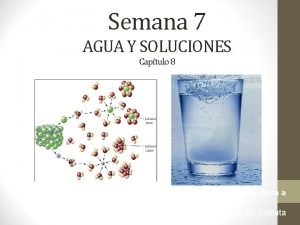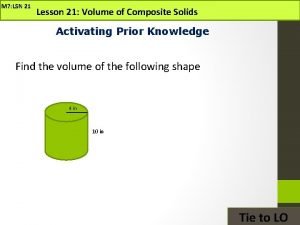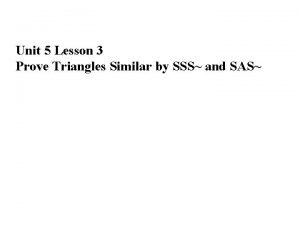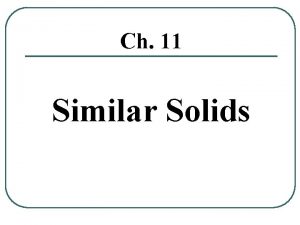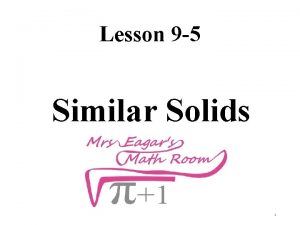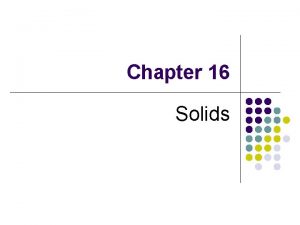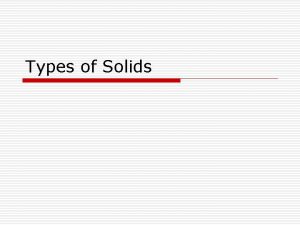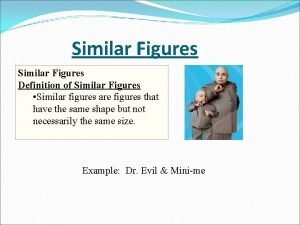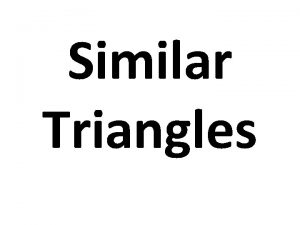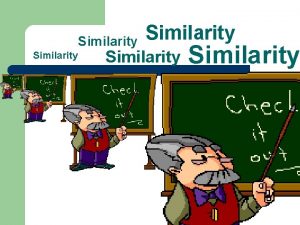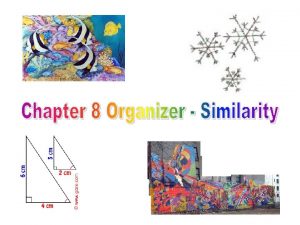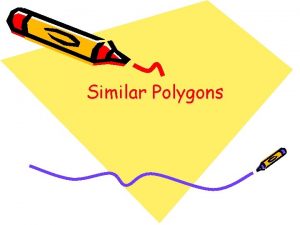Lesson 9 5 Similar Solids Lesson 9 5














- Slides: 14

Lesson 9 -5 Similar Solids Lesson 9 -5: Similar Solids 1

Similar Solids Two solids of the same type with equal ratios of corresponding linear measures (such as heights or radii) are called similar solids. Lesson 9 -5: Similar Solids 2

Similar Solids Similar solids NOT similar solids Lesson 9 -5: Similar Solids 3

Similar Solids & Corresponding Linear Measures To compare the ratios of corresponding side or other linear lengths, write the ratios as fractions in simplest terms. 6 12 Length: 12 = 3 8 2 3 8 width: 3 2 4 2 height: 6 = 3 4 2 Notice that all ratios for corresponding measures are equal in similar solids. The reduced ratio is called the “scale factor”. Lesson 9 -5: Similar Solids 4

Example: Are these solids similar? Solution: 9 12 6 12 8 16 All corresponding ratios are equal, so the figures are similar Lesson 9 -5: Similar Solids 5

Example: Are these solids similar? Solution: 18 6 8 4 Corresponding ratios are not equal, so the figures are not similar. Lesson 9 -5: Similar Solids 6

Scale Factor and Area What happens to the area when the lengths of the sides of a rectangle are doubled? Ratio of sides = 1: 2 Ratio of areas = 1: 4 What is the scale factor for the two rectangles? The ratio of the areas can be written as Lesson 9 -5: Similar Solids 1: 2 12: 22 7

Similar Solids and Ratios of Areas l l If two similar solids have a scale factor of a : b, then corresponding areas have a ratio of a 2: b 2. This applies to lateral area, surface area, or base area. Ratio of sides = 3: 2 12 8 6 9 9 Surface Area = B + L. A. = 9(9) + (9 + 9 + 9)(12)/2 = 81 +216 = 297 6 Surface Area = B + L. A. = 6(6) + (6 + 6 + 6)(8)/2 = 36 + 96 = 132 Ratio of surface areas: 297: 132 = 9: 4 = 32: 22 8

Scale Factor and Volume What happens to the surface area and volume when the lengths of the sides of a prism are doubled? Ratio of sides = 1: 2 Ratio of areas = 1: 4 Ratio of volumes = 1: 8 The scale factor for the two prisms is The ratio of the surface areas can be written as The ratio of the volumes can be written as Lesson 9 -5: Similar Solids 1: 2 12: 22 13: 23 9

Similar Solids and Ratios of Volumes l If two similar solids have a scale factor of a : b, then their volumes have a ratio of a 3 : b 3. 9 15 6 Ratio of heights = 3: 2 V = r 2 h = (92) (15) = 1215 10 V= r 2 h = (62)(10) = 360 Ratio of volumes: 1215 : 360 = 27: 8 = 33: 23 Lesson 9 -5: Similar Solids 10

Example 1: These two solids are similar. a. The scale factor is b. c. 18: 6 = 3: 1 The ratio of areas is 182: 62 = 32: 12 = 9: 1 The ratio of volumes is 183: 63 = 33: 13 = 27: 1 18 m Lesson 9 -5: Similar Solids 6 m 11

Example 2: These two solids are similar. If the radius of the larger cone is 6 m, what is the radius of the smaller cone? Solution: Write a proportion. 18 m Lesson 9 -5: Similar Solids 6 m 12

Example 3: These two solids are similar. If the lateral area of the smaller cone is 12 , what is the lateral area of the larger cone? Solution: Write a proportion. Use ratio of AREAS. 18 m Lesson 9 -5: Similar Solids 6 m 13

Example 4: Volume of larger is 27 times volume of smaller! These two solids are similar. If the volume of the larger cone is 96 , what is the volume of the smaller cone? Solution: Write a proportion. Use ratio of VOLUMES. 18 m Lesson 9 -5: Similar Solids 6 m 14
 Similar images
Similar images Similar solids
Similar solids Similar solids
Similar solids Similar figures
Similar figures Similar solids definition
Similar solids definition Similar solids
Similar solids Congruent and similar solids
Congruent and similar solids Find similar images
Find similar images Lesson 1 thermal energy and the behavior of matter
Lesson 1 thermal energy and the behavior of matter Similar disuelve a similar
Similar disuelve a similar Similar disuelve a similar
Similar disuelve a similar Similar
Similar Paraphrasing proverbs
Paraphrasing proverbs Lesson 21 volume of composite solids
Lesson 21 volume of composite solids Unit 5 lesson 3 geometry
Unit 5 lesson 3 geometry
